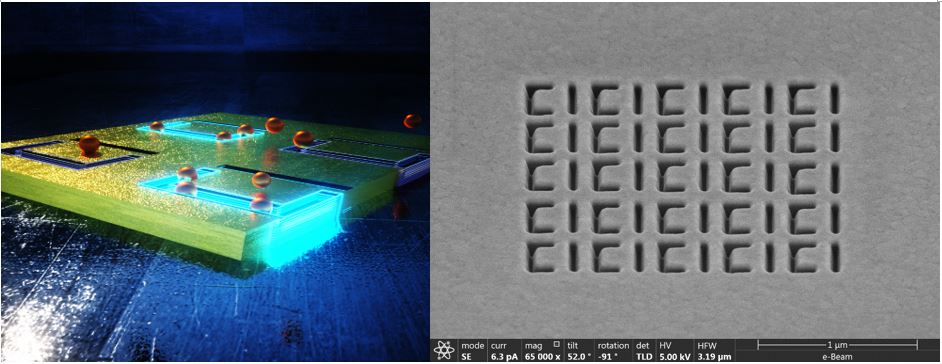Jul 27 2020
Nanoparticles appear to be tiny. They measure only 1/1000th of a millimeter, and hence cannot be seen with the naked eye. Although they are small, they are highly crucial in several ways.
 The asymmetric split rings successfully trapped 20 nm polystyrene particles at certain regions. Image Credit: Okinawa Institute of Science and Technology Graduate University.
The asymmetric split rings successfully trapped 20 nm polystyrene particles at certain regions. Image Credit: Okinawa Institute of Science and Technology Graduate University.
The ability to isolate and track nanoparticles is essential to have a close look at viruses, proteins, or DNA.
To trap such particles, a laser beam must be rigidly focused to a point that generates a powerful electromagnetic field. This beam will have the ability to hold particles similar to a pair of tweezers. However, this method is hampered by certain natural limitations.
The most prominent among these are the size limitations—the method is not applicable if the particle is too small. Until now, optical tweezers have not been able to hold particles such as individual proteins, which measure only a few nanometers in diameter.
Latest advances in nanotechnology have enabled scientists in the Light-Matter Interactions for Quantum Technologies Unit at the Okinawa Institute of Science and Technology Graduate University (OIST) to design a method for accurate trapping of nanoparticles.
In this research, the team addressed the natural limitations by designing optical metamaterials-based tweezers. Metamaterials are synthetic materials with particular properties that do not occur by nature. For the first time, the researchers used this type of metamaterial for trapping single nanoparticle.
Being able to manipulate or control these small particles is crucial for advances in biomedical science. The potential applications for society are far-reaching.
Dr Domna Kotsifaki, Staff Scientist, Okinawa Institute of Science and Technology
Kotsifaki is the study first author of the research paper that was published in Nano Letters. Dr Kotsifaki explained that by trapping such nanoparticles, scientists could observe the advancement of cancer, develop effective drugs, and optimize biomedical imaging.
This novel method has two desirable capabilities—it can steadily trap the nanoparticles by making use of low-intensity laser power and can be utilized for a long period while preventing damage to the sample by light.
This was the result of the metamaterial selected by the researchers. This metamaterial is highly sensitive to variations in the surrounding environment, and hence enables the use of low-intensity laser power.
Metamaterials have unusual properties due to their unique design and structure. But this makes them very useful. Over the last few years, a whole new era of devices with novel concepts and potential applications has been created from them. From the metamaterial, we fabricated an array of asymmetric split rings using a beam of ions – tiny, charged particles – on a 50 nm gold film.
Dr Domna Kotsifaki, Staff Scientist, Okinawa Institute of Science and Technology
To check if the method was successful, the researchers irradiated the device using near-infrared light and trapped polystyrene particles measuring 20 nm at specific regions on it.
Together with her collaborators, Dr Kotsifaki looked for the trap stiffness, which relates to trapping performance.
The achieved trapping performance was several times better than that of conventional optical tweezers and the highest reported to date as far as we know. As the first group to use this device for precision nanoparticle trapping, it has been rewarding to contribute to such progress in this research area.
Dr. Domna Kotsifaki, Staff Scientist, Okinawa Institute of Science and Technology
Currently, the team plans to tune the device to check whether these tweezers can be employed in real-world applications. Particularly, in the upcoming days, this device could be used to make lab-on-chip technologies, which are hand-held, diagnostic tools that can offer results in an inexpensive and efficient manner.
Besides its applications in the field of biomedical science, this study has offered new and basic insights into nanotechnology and the behavior of light at the nanoscale.
Apart from Dr Domna Kotsifaki, the research group included Professor Síle Nic Chormaic, who heads the OIST Unit, and staff scientist, Dr Viet Giang Truong.
Journal Reference
Kotsifaki, D. G., et al. (2020) Fano-Resonant, Asymmetric, Metamaterial-Assisted Tweezers for Single Nanoparticle Trapping. Nano Letters. doi.org/10.1021/acs.nanolett.0c00300.